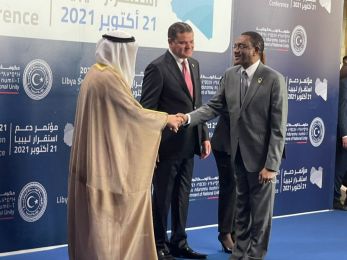PANAPRESS
Panafrican News Agency
UN agency aids Eastern Kenyan drought victims
Nairobi, Kenya (PANA) - The UN International Organisation for Migration (IOM) said Friday it was helping pastoralists in north-eastern Kenya affected by the extreme effects of drought and are sharing scant resources with large numbers of Somalis who continue to arrive in the area on a daily basis.
The organisation is spending US$ 400,000, provided by the UN Central Emergency Response Fund (CERF) to assist some 40,000 vulnerable pastoralists in the region, 60 per cent of them women.
“The funds will be used in a six-month emergency programme that will involve the re-stocking of households with camels, which are more resistant to drought and diseases than the traditional goats and sheep and will provide milk to beneficiaries,” IOM said in a statement.
The emergency programme included the rehabilitation of water retention structures and wells along livestock migratory routes, the provision and distribution of health kits and supplement feed for the livestock.
Community training for herders on pasture storage, conservation and use will also take place.
This initiative will involve local communities in the construction and maintenance of efficient water harvesting structures, which should help provide additional income through food growing activities that will help beneficiaries cope with ever increasing food prices.
IOM is working in partnership with the Kenya's Ministry of Livestock, as well as the Food and Agriculture Organisation (FAO), local NGOs and community leaders.
Pastoralist communities are particularly affected by the drought as they face the imminent threat of losing their livelihoods as their weakened herds struggle to survive disease, hunger and thirst in an increasingly desperate search for pasture and water.
While humanitarian agencies at Dadaab are focussing on providing much needed assistance to the daily flow of refugees, more attention needs to be paid to the needs of the host communities.
The three Dadaab refugee camps, which were originally meant to shelter 90,000 people, are now accommodating more than 383,000 people, making them the largest refugee camps in the world.
Meanwhile, IOM's project to provide emergency assistance to counter acute watery diarrhoea outbreaks in the northern Turkana County has received a boost from CERF funding to the tune of US$ 115,000.
Under the project, IOM will work in close collaboration with the local and international health partners, including AMREF, WHO, IRC and MSF, to reach some 55,000 vulnerable individuals, mostly women and children under the age of five.
This group is particularly at risk of water-borne diseases due to the drought, which is forcing them to use contaminated water.
IOM will assist in the provision of essential drugs and equipment to the district medical centres and will contribute towards the containment of the outbreak through the provision of water purification tablets and through community awareness raising activities.
IOM has in the past implemented three emergency health response projects through CERF allocations following cholera outbreaks in northern Kenya.
-0- PANA AO/BOS 22July2011
The organisation is spending US$ 400,000, provided by the UN Central Emergency Response Fund (CERF) to assist some 40,000 vulnerable pastoralists in the region, 60 per cent of them women.
“The funds will be used in a six-month emergency programme that will involve the re-stocking of households with camels, which are more resistant to drought and diseases than the traditional goats and sheep and will provide milk to beneficiaries,” IOM said in a statement.
The emergency programme included the rehabilitation of water retention structures and wells along livestock migratory routes, the provision and distribution of health kits and supplement feed for the livestock.
Community training for herders on pasture storage, conservation and use will also take place.
This initiative will involve local communities in the construction and maintenance of efficient water harvesting structures, which should help provide additional income through food growing activities that will help beneficiaries cope with ever increasing food prices.
IOM is working in partnership with the Kenya's Ministry of Livestock, as well as the Food and Agriculture Organisation (FAO), local NGOs and community leaders.
Pastoralist communities are particularly affected by the drought as they face the imminent threat of losing their livelihoods as their weakened herds struggle to survive disease, hunger and thirst in an increasingly desperate search for pasture and water.
While humanitarian agencies at Dadaab are focussing on providing much needed assistance to the daily flow of refugees, more attention needs to be paid to the needs of the host communities.
The three Dadaab refugee camps, which were originally meant to shelter 90,000 people, are now accommodating more than 383,000 people, making them the largest refugee camps in the world.
Meanwhile, IOM's project to provide emergency assistance to counter acute watery diarrhoea outbreaks in the northern Turkana County has received a boost from CERF funding to the tune of US$ 115,000.
Under the project, IOM will work in close collaboration with the local and international health partners, including AMREF, WHO, IRC and MSF, to reach some 55,000 vulnerable individuals, mostly women and children under the age of five.
This group is particularly at risk of water-borne diseases due to the drought, which is forcing them to use contaminated water.
IOM will assist in the provision of essential drugs and equipment to the district medical centres and will contribute towards the containment of the outbreak through the provision of water purification tablets and through community awareness raising activities.
IOM has in the past implemented three emergency health response projects through CERF allocations following cholera outbreaks in northern Kenya.
-0- PANA AO/BOS 22July2011






